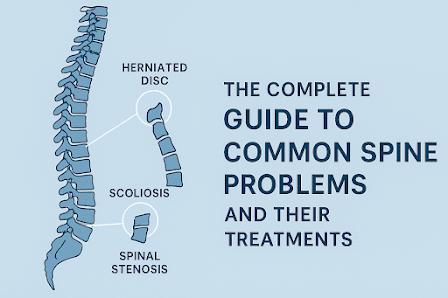The Complete Guide to Common Spine Problems and Their Treatments
Spinal health is vital for mobility, strength, and quality of life. Millions of people suffer from back and neck disorders, yet many delay treatment until pain disrupts daily activities. This guide explores the most common spine problems and their treatments.
Common Spine Problems
Herniated Disc
A herniated disc occurs when the soft inner core of a spinal disc pushes out, pressing on nearby nerves. It often causes back pain, leg numbness, and sciatica.
Spinal Stenosis
Spinal stenosis happens when the spinal canal narrows, compressing nerves. Symptoms include tingling, weakness, and pain in the legs, especially while walking.
Scoliosis
Scoliosis is an abnormal sideways curvature of the spine. In children, it may progress during growth spurts, while in adults it can cause uneven posture and chronic pain.
Degenerative Disc Disease
Degenerative disc disease results from natural wear and tear of discs, leading to stiffness, pain, and reduced flexibility. It is more common with aging.
Spondylolisthesis
Spondylolisthesis occurs when one vertebra slips over another, causing instability, nerve compression, and lower back pain.
Osteoporosis-Related Fractures
Weakened bones from osteoporosis can cause spinal compression fractures, leading to sudden pain, loss of height, and spinal deformity.
Treatment Options
Non-Surgical Treatments
- Physical therapy: Improves mobility, strengthens muscles, and reduces pain.
- Medications: Pain relievers, anti-inflammatories, and muscle relaxants.
- Injections: Epidural steroid injections relieve inflammation around spinal nerves.
- Lifestyle modifications: Weight management, posture correction, and core strengthening.
Surgical Treatments
- Discectomy: Removes the herniated portion of a disc.
- Laminectomy: Relieves pressure by removing part of the vertebra.
- Spinal fusion: Stabilizes the spine by fusing vertebrae together.
- Artificial disc replacement: Preserves motion while treating damaged discs.
- Minimally invasive surgery: Reduces recovery time and scarring.
Preventing Spine Problems
- Maintain good posture while sitting, standing, and lifting.
- Exercise regularly with a focus on core strength.
- Quit smoking to promote spinal bone health.
- Ensure adequate calcium and vitamin D intake.
- Avoid prolonged sitting and stay active.
Conclusion
Spine problems like herniated discs, scoliosis, and degenerative changes can disrupt life, but timely diagnosis and treatment restore health. Early intervention prevents long-term disability.
Strong spinal care, healthy habits, and expert medical guidance are the key to mobility and pain-free living. Seek medical advice if symptoms persist.
👉 Consult our Dr. Sreenath Rao Jakinapally spine surgeon for expert care.


Recent Comments